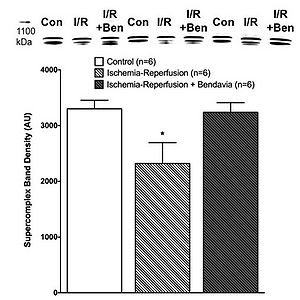Brown DA 2014 Abstract MiP2014
| The cardiolipin-targeting peptide Bendavia preserves post-ischemic mitochondrial energetics by sustaining respiratory supercomplexes. |
Link:
Mitochondr Physiol Network 19.13 - MiP2014
Brown DA, Moukdar F, Alleman RJ, Lark DS, Neufer PD, Shaikh SR (2014)
Event: MiP2014
Bendavia is a cytoprotective mitochondria-targeting peptide [1-4], currently being tested in the EMBRACE-STEMI trial for reducing injury during acute coronary syndromes. We previously showed that the cardioprotective effects of Bendavia involved improving cardiolipin-dependent mitochondrial membrane fluidity. As membrane fluidity influences the ability of proteins to assemble, we hypothesized that a consequence of augmented membrane fluidity would be higher expression of mitochondrial respiratory supercomplexes. Rat hearts (N=42) were subjected to ischemia-reperfusion (I/R) with our without 1 nM Bendavia perfusion, beginning at the onset of reperfusion. Left ventricular tissue was split into one of two study arms: 1. Supercomplex expression using blue-native gel electrophoresis (BN-PAGE), or 2. High-resolution respirometry using permeabilized ventricular fibers. For BN-PAGE studies, respiratory supercomplex bands were decreased with I/R, and restored with Bendavia (Fig. 1). High-resolution respirometry studies indicated suppressed Complex I-dependent respiration after I/R (208±19 v 42±9 pmol O2∙s-1.mg-1) in control v I/R, respectively; P<0.05. Complex II-dependent respiration was also lower (753±41 v 168±13 pmol∙s-1∙mg-1 in control versus I/R; P<0.05). Perfusion with Bendavia during reperfusion significantly increased Complex I- (100±13 pmol O2∙s-1.mg-1) and II-dependent (334±63 pmol O2∙s-1.mg-1) respiration (P<0.05 versus untreated IR for both). Taken together, these data suggest that Bendavia’s protective mechanism of action involves preserving supercomplex-dependent mitochondrial function during cardiac reperfusion.
• O2k-Network Lab: US NC Greenville Neufer PD, US VA Blacksburg Brown DA
Labels: MiParea: Respiration, mt-Membrane, Pharmacology;toxicology
Stress:Ischemia-reperfusion Organism: Rat Tissue;cell: Heart Preparation: Permeabilized tissue Enzyme: Supercomplex
Coupling state: OXPHOS Pathway: N, S HRR: Oxygraph-2k Event: C3, Oral MiP2014
Affiliation
1-Dep Physiology; 2-East Carolina Diabetes Obesity Inst; 3-Dep Biochem Molec Biol, Brody School Medicine, East Carolina Univ, Greenville, NC, USA. - [email protected]
Figures
Figure 1: Maintenance of mitochondrial supercomplexes after ischemia/reperfusion (I/R) with the mitochondria-targeting peptide Bendavia.
References
- Brown DA, Hale SL, Baines CP, Rio CL, Hamlin RL, Yueyama Y, Kijtawornrat A, Yeh ST, Frasier CR, Stewart LM, Moukdar F, Shaikh SR, Fisher-Wellman KH, Neufer PD, Kloner RA (2013) Reduction of early reperfusion injury with the mitochondria-targeting peptide Bendavia. J Cardiovasc Pharmacol Therapeut 19: 121-32.
- Chakrabarti AK, Feeney K, Abueg C, Brown DA, Czyz E, Tendera M, Janosi A, Giugliano RP, Kloner RA, Weaver WD, Bode C, Godlewski J, Merkely B, Gibson CM (2013) Rationale and design of the Embrace Etemi study: a phase 2a, randomized, double-blind, placebo-controlled trial to evaluate the safety, tolerability and efficacy of intravenous Bendavia on reperfusion injury in patients treated with standard therapy including primary percutaneous coronary intervention and stenting for ST-segment elevation myocardial infarction. Am Heart J 165: 509-14 e507.
- Kloner RA, Hale SL, Dai W, Gorman RC, Shuto T, Koomalsingh KJ, Gorman JH, Sloan RC, Frasier CR, Watson CA, Bostian PA, Kypson AP, Brown DA (2012) Reduction of ischemia/reperfusion injury with bendavia, a mitochondria-targeting cytoprotective peptide. J Am Heart Assoc 1: e001644.
- Sloan RC, Moukdar F, Frasier CR, Patel HD, Bostian PA, Lust RM, Brown DA (2012) Mitochondrial permeability transition in the diabetic heart: Contributions of thiol redox state and mitochondrial calcium to augmented reperfusion injury. J Molec Cell Cardiol 52: 1009-18.

